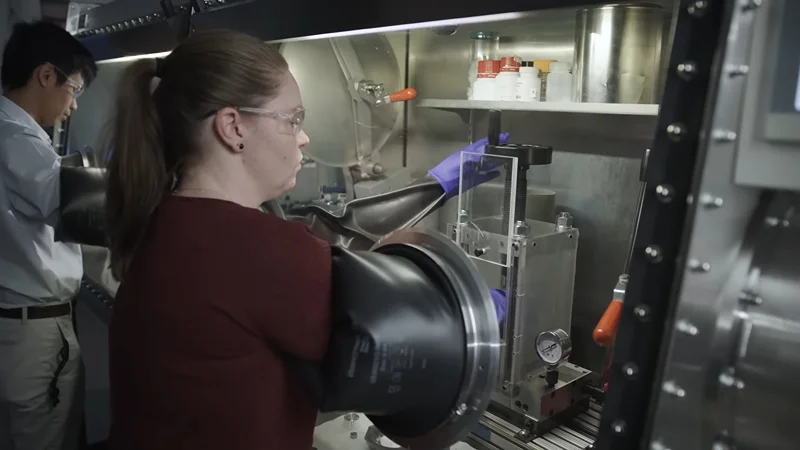Traditionally, the process of finding new battery materials has been laborious and time-consuming, relying on trial and error with limited insights from success stories. Now, Microsoft and PNNL are showcasing the potential of AI-enhanced discovery, demonstrating that the combination of advanced AI and high-performance cloud computing can yield results in a matter of weeks rather than years.
Collaboration between Microsoft and the Pacific Northwest National Laboratory(PNNL), advanced artificial intelligence(AI), and cloud computing are transforming the landscape of battery material discovery. The fusion of Microsoft’s AI prowess with PNNL’s expertise in chemistry and materials science has already yielded a promising new battery material, promising to revolutionize the energy solutions our world desperately needs.
Microsoft Quantum Team’s AI-powered Selection Process
Microsoft’s Quantum team employed AI to sift through a staggering 32 million potential inorganic materials in just 80 hours using Azure Quantum Elements. The AI algorithm proposed 500,000 stable materials, reducing the list further to 800, showcasing the efficiency of AI in narrowing down potential candidates.
Hybrid Approach: AI and High-Performance Computing (HPC)
Recognizing the need for accuracy, the next phase incorporated HPC, a computing powerhouse that used density functional theory and molecular dynamics simulations. This hybrid approach reduced the list to 150 candidates, emphasizing the synergy between AI’s speed and HPC’s precision.
AI in Chemistry: A Quantum Leap Forward
Microsoft’s AI tools, tailored for chemistry, played a pivotal role, accounting for 90% of computational time. This underscores their versatility, not limited to battery systems but applicable to various materials research. The cloud-based nature of these tools enhances accessibility for research communities, eliminating the constraints of shared supercomputers at universities.
Promising Material and Its Unconventional Composition
AI-HPC collaboration identified a novel solid-state electrolyte material, challenging conventional wisdom. Contrary to the assumption that sodium and lithium ions couldn’t coexist due to their similar charges and different sizes, the material demonstrated their compatibility. Moreover, the molecular structure naturally facilitated ion movement through the electrolyte.
At #Davos2024, @Microsoft #CEO @SatyaNadella talked about #MatterGen, their #GenerativeAI they used to create a new battery molecule that uses 70% less lithium.
He notes #AI like this can give us 10x leaps.
Details on MatterGen: https://t.co/FbiJ1eNZsX#LLMs @MSFTResearch pic.twitter.com/iTHWQmZmqY
— Dion Hinchcliffe (@dhinchcliffe) January 26, 2024
Reducing Lithium Dependency: A Sustainable Approach
The newly discovered material incorporates both lithium and sodium, potentially reducing lithium content by up to 70%. While it’s still in the early stages, this reduction addresses concerns about the scarcity and environmental impact of lithium mining. The material’s synthesis has progressed to prototype batteries, marking a crucial step toward sustainable energy solutions.
Speeding Up the Scientific Process
The collaboration’s success isn’t just about the specific battery material but the unprecedented speed at which it was identified. The iterative and time-consuming nature of traditional methods is contrasted by this rapid approach, emphasizing the transformative power of AI in scientific discovery.
From Millions to Promising Candidates
Microsoft’s AI algorithms efficiently filtered out stable materials from the vast pool of candidates, significantly reducing the exploration time. Subsequent validation through HPC techniques further refined the selection, resulting in a shortlist of 23 highly promising materials, five of which were previously known. This streamlined approach, powered by AI and HPC, exemplifies the potential of technology in accelerating scientific discovery.
Reference Video
FAQ’s
Why is reducing lithium content important in battery materials?
Lithium scarcity and environmental concerns associated with mining make reducing lithium content crucial for sustainable battery development. The new material's potential to cut lithium usage by up to 70% is a significant step toward addressing these issues. The material challenges preconceived notions by allowing the coexistence of sodium and lithium ions in a solid-state electrolyte system. Its molecular structure further facilitates ion movement, showcasing unexpected benefits.
Bottom Up
Microsoft and PNNL exemplify the transformative potential of AI and cloud computing in accelerating scientific discovery. The rapid identification of a promising new battery material not only signifies a leap forward in energy solutions but also sets the stage for the broader application of these technologies across scientific fields. This collaborative effort marks a significant milestone on the precipice of a new era in scientific acceleration.
In summary, the convergence of AI, cloud computing, and scientific expertise heralds a new frontier in materials discovery, paving the way for unprecedented advancements and solutions to some of the world’s most pressing problems.

